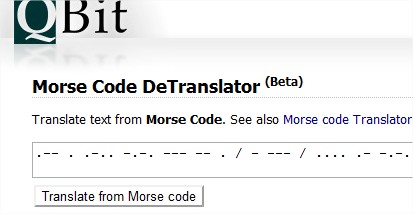

#Decode morse code code#
Read audio file in WAV format, extract the morse code and write translated text into standard output. See program help with command line flag -h: $ morse-audio-decoder -h The program decodes audio morse code in the WAVFILE argument, and writes translation to standard output.

Where WAVFILE is path to the audio file to be processed. Or alternatively, python -m morse_audio_decoder WAVFILE To run the script installed with pip, perform morse-audio-decoder WAVFILE
#Decode morse code install#
# take note of the build step output, install package from the dist folder You can install this package from pip, with pip install morse-audio-decoderĬlone code repository from your local machine, install from there: git clone The program reads wav audio file, and outputs decoded morse code in standard output. 11, whose instructions can be found in their GitHub.

The images above represents the text "BOX" written in Morse code.This program is in solution to Wunderdog Wundernut vol. Morse code speed is therefore specifying the time unit length (dot duration). Therefore typical words such as "PARIS" (which is 50 time units long) or "CODEX" (which is 60 time units long) are used to measure the speed. This is not unproblematic, because words can have different lengths and the letter can have different dot lengths. Morse code speed is commonly measured in words per minute. There are never two marks in a row, or two gaps in a row. Note that marks and gaps always alternate. Within-character gap, between the dots and dashes within a morse character: 0.These five elements can also be expressed as binary codes: Between-words gap, which is seven time units long.Between-characters gap, which is three time units long.Within-character gap, between the dots and dashes within a morse character, which is one time unit long.Long mark, "dash" or "dah" (-), which is three time units long.Short mark, "dot" or "dit" (.), which is one time unit long.International Morse code (ITU) consists of five elements: Historians have called morse code the first digital code. Morse code during mine rescues by pulling a rope. Morse code can be transmitted in multiple ways such as sounds, a common flashlight, electrical pulses on a telegraph line, mechanical, etc. International Morse Code standard (ITU) in 1865, that is still being used today. Later, Morse code was adapted to radio communications by transmitting the pulses as short and long tones.Ī new and improved version of the Morse code alphabet was proposed by Friedrich Clemens Gerke in 1848, that was adopted by the German-Austrian Telegraph Society. Morse operators soon learned that the telegraph was making sounds when receiving the code and that they could translate the sound instead of looking at the paper tape. This code was first used in 1844 and was called Morse landline code, or American Morse code. Operators could then translate the markings on the paper tape into text messages.Īlfred Vail estimated the frequency of letters in the English language and assigned the letters most commonly used the shorter Morse code sequences, while the more infrequent letters wereĪssigned longer sequences. Morse's original telegraph receiver used a clockwork and an electromagnet to mark the received pulses Invented a simple telegraph system that used only electrical pulses and silence between them. Samuel Morse, together with Joseph Henry and Alfred Vail

The development of the earliest telegraph systems started in the 19th century following the discovery of electromagnetism in 1820. Morse code is frequently used in geocaching mystery caches (puzzle caches), CTFs and logic puzzles.


 0 kommentar(er)
0 kommentar(er)
